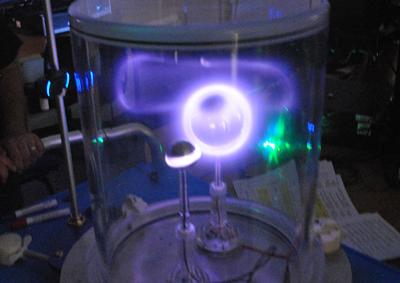Home
Return to the home page.
The Planeterrella is an incredible artificial demonstration of the Northern Lights, bringing the majesty and awe of the aurora to schools and the public near Southampton. Keep reading to discover this amazing experiment, and find out about some of the scientific phenomena it emulates and the history behind them.

The first terrella was created by Kristian Birkeland, a Norwegian scientist and explorer who lead several expeditions to northern Norway at the end of the 19th century. He theorised that the aurora were caused by the solar wind, a stream of charged particles crossing the vacuum of space from the sun to the Earth.
He created the terrella to test his hypothesis, placing a magnetic sphere (representing Earth) in a vacuum chamber and simulating the solar wind by firing electrons at the sphere. The experiment worked, and he successfully observed auroral displays on the miniature Earth in the vacuum chamber.
More recently, Jean Lilensten, director of research at l'Institut de planétologie et d'astrophysique de Grenoble (IPAG) in France, has created the Planeterrella, a more modern version of the experiment which includes two spheres, one acting as the Earth and the other acting as the Sun. This allows for auroral displays to be brought into classrooms and events, allowing people who have never before seen the Northern Lights a glimpse into their beauty and the science behind them.
If you're interested in arranging for the Northern Lights to come to you, please book a show by clicking the button below.
The Northern Lights are a natural wonder of the world, an incredible light show seen in bands around the poles of the Earth (& other planets!). The Northern Lights are also known as the aurora borealis and have a southern counterpart called the southern lights (or aurora australis).
The aurora is generated when the magnetic field of the Earth is disturbed by the solar wind. The disturbance causes particles (mainly electrons and protons) from the solar wind and near-Earth space to collide with the atmosphere in bands around the magnetic poles. The Northern Lights are rarely seen in the UK, if you want to see it then you'll have a better chance at higher latitudes in countries such as Norway, Finland, Canada and US.

Historical records of the aurora stretch back as far as the Romans and ancient Greeks. In one text Seneca, a Roman philosopher, recalls how an army thought the aurora was a city on fire over the horizon and rushed to put out the flames. The word aurora comes from the latin for dawn, but it wasn't called this at that time. Because the phonomena behind the aurora was not understood the sightings were often viewed with superstition or as religious omens.
Galileo Galilei was probably the first to coin the term aurora borealis, though he did not know the origins of the effect. Edmund Halley (mostly known for calculting the orbit of Halley's comet) was the first to suggest that the auroral display was ordered or controlled by the Earth's magnetic field. One of the major breakthrough works was published by William Gilbert, chief physician to Queen Elizabeth. He wrote "That the globe of the Earth is magnetic ...", and used a small lobestone (that he called a terrella) to communicate his ideas.
In 1740, Ander Celsius (whose temperature scale we use today in the UK) reported that magnetic compasses were always in motion and were strongly moved when the aurora passed overhead.
Apart from being an incredible natural light display the aurora is important and can effect modern life.
In 1859 there was a massive solar storm, known as the Carrington Event. The solar storm released a huge coronal mass ejection (CME) which collided with the Earth's magnetosphere. The impact created the largest geomagnetic storm on record. This had several effects, the first of which was that the aurora moved down to lower latitudes and was seen as far south as the Caribbean, Mexico and Africa. The aurora was so bright people in the north of the United States could read books by its light. More worringly telegraph systems all over Europe and the US failed, the currents overhead generated huge power spikes in the networks. In one case a network was disconnected from the power source and still worked, briefly confusing the operators:
Boston operator (to Portland operator): "Please cut off your battery [power source] entirely for fifteen minutes."
Portland operator: "Will do so. It is now disconnected."
Boston: "Mine is disconnected, and we are working with the auroral current. How do you receive my writing?"
Portland: "Better than with our batteries on. – Current comes and goes gradually."
Boston: "My current is very strong at times, and we can work better without the batteries, as the aurora seems to neutralize and augment our batteries alternately, making current too strong at times for our relay magnets. Suppose we work without batteries while we are affected by this trouble."
Portland: "Very well. Shall I go ahead with business?"
Boston: "Yes. Go ahead."
It is thought that a storm of this size would cause huge problems in the modern world were one to happen, blowing power lines and disrupting worldwide communications and radios.
More recently, in 1989, a smaller geomagnetic storm struck and damaged the power lines in Quebec, Canada, causing a blackout. The aurora was seen as far south as Texas and Florida. As this occured during the cold war some assumed that it was the result of a nuclear strike.
Return to the home page.
Find out more about making a booking.
Find out about recent news and events.